Considering that the last IMBB I took part in was #16, it would appear that I've been absent from the IMBB scene a very long time indeed.
Still, better late than never, I suppose.
Many, many thanks to Laura from Cucina Testa Rossa for hosting this IMBB. Chère Laura, je vous remercie de ce thème.
I know it seems like the easy option, given the absolutely enormous scope of this IMBB, but I've been itching to try my hand at Boeuf Bourguignon for the longest time, and I can think of no better dish that would go so well with a glass of wine. Hailing from the region of Burgundy, Boeuf Bourguignon (or Beef Burgundy, for all you Anglophiles), is one of those très traditionnel dishes that is to be found at any decent French restaurant, along with such favourites as Blanquette de Veau and Coq au Vin.
As with any stew, all you really need is some cheap meat, red wine, beef stock, cheap vegetables and the ability to wait for your dish to cook itself. C'est tout!
Now, when it comes to French classics, you know there's none more so than Julia, so with apologies to the Madame:
Ingredients (Serves 6)
150g of bacon (optional)
1 Tb olive oil
1.4 kg lean stewing beef cubes
1 sliced carrot
1 sliced onion
1 sliced celery
200g sliced mushrooms
2 Tb flour
3 cups red wine
2 - 3 cups beef stock
1 Tb tomato paste
2 cloves mashed garlic
A few Thyme sprigs
1 Rosemary sprig
1 Bay leaf
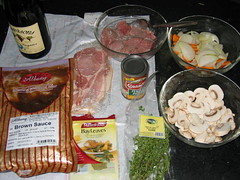
Some notes on the ingredients: Stewing cuts for beef include cuts from the rump and chuck (backside and shoulder). You may cube these yourself or buy them already prepared from the Swiss Butchery. If you decide not to use the bacon, remember to use a few more tablespoons of olive oil.
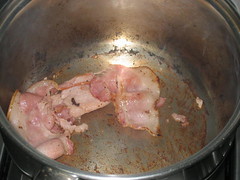
Start off by frying your bacon with the olive oil in a pot deep enough to hold all the ingredients (the last thing you want is to have your wine and stock overflow). While that's taking care of itself, coat your beef cubes lightly with the flour, which helps dry them out and aids in browning them.
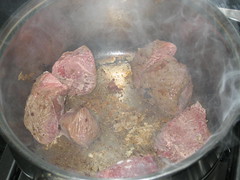
Once your bacon has rendered a goodish amount of fat, remove it and start to sear your beef cubes. Try not to set off any smoke detectors. Make sure there's enough oil in the pot, or your meat won't form a nice crust and all your flour will just stick to the base of the pot, as you can see here.
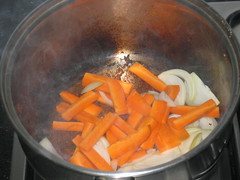
Remove your meat and toss in the garlic and vegetables to brown. Carrots, onions and celery are good friends, so don't be afraid to keep them in there a little longer.
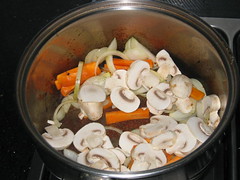
Not too long though, because the mushrooms want a piece of the action too. Throw them in to cook till they've turned golden and start glistening.
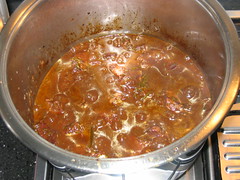
Since the meat requires a much longer time to cook than the vegetables, remove the vegetables to a separate container while you return the meat to the pot, along with the wine, stock, tomato paste and herbs. The liquid should just about cover the meat. Feel free to add in a cup of water to reduce the saltiness of your stewing liquid. Let it simmer away on your stovetop for an hour, topping up the liquid every fifteen minutes or so with water (you could use wine or stock, but that does make the sauce a bit salty).
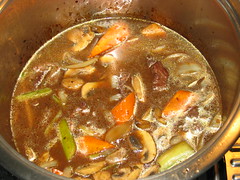
After an hour, add your vegetables to the mix and continue to let the stew simmer for another hour or so. Now you may notice that I'm being quite imprecise about the time. This is because I can assure you that this particular stew requires at least 2 hours to cook, if not more, depending on how much meat you're cooking. So please budget on about 2 - 3 hours cooking time. The best test is the fork test; if a fork pierces the beef easily, it's cooked. Having said that though, it's almost impossible to overcook stews, so if your beef is tough and stringy, it means you've undercooked rather than overcooked it.
Once the meat is tender, Julia recommends removing all the vegetables and meat in order to boil down the sauce to thicken it. You could do this, though it's a bit of work. You could also thicken it by using beurre manié or kneaded butter, which is basically just 1 tablespoon of butter and 1 tablespoon of flour mixed to form a dough and whisked into your sauce over low heat till the desired thickness. Or, you could just be lazy and leave your stew as it is. C'est okay, really.
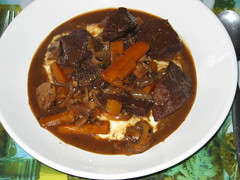
As you can see, I was a bit greedy in dishing out the stew. I served it with some last-minute mashed potatoes, but it'll go well with couscous, risotto, noodles, just about any sort of carbohydrate.
Boeuf Bourguignon, like all stews, refrigerates and freezes extremely easily, and tastes even better the next day once all the flavours have had time to develop and bloom.
As Julia says, "carefully done, and perfectly flavoured, it is certainly one of the most delicious beef dishes concocted by man". Now, she may be indulging in a little culinary hyperbole, but she's not that far from the truth.
Et voilà, ma contribution à l'IMBB de ce mois-ci et bon appétit à tous!
Footnote: I know I was supposed to include a glass of wine, but considering this recipe used a good half-bottle of wine, I'm sure I'll be forgiven for that small omission.
Technorati Tags: Recipes, IMBB23, French, Boeuf Bourguignon



No comments:
Post a Comment